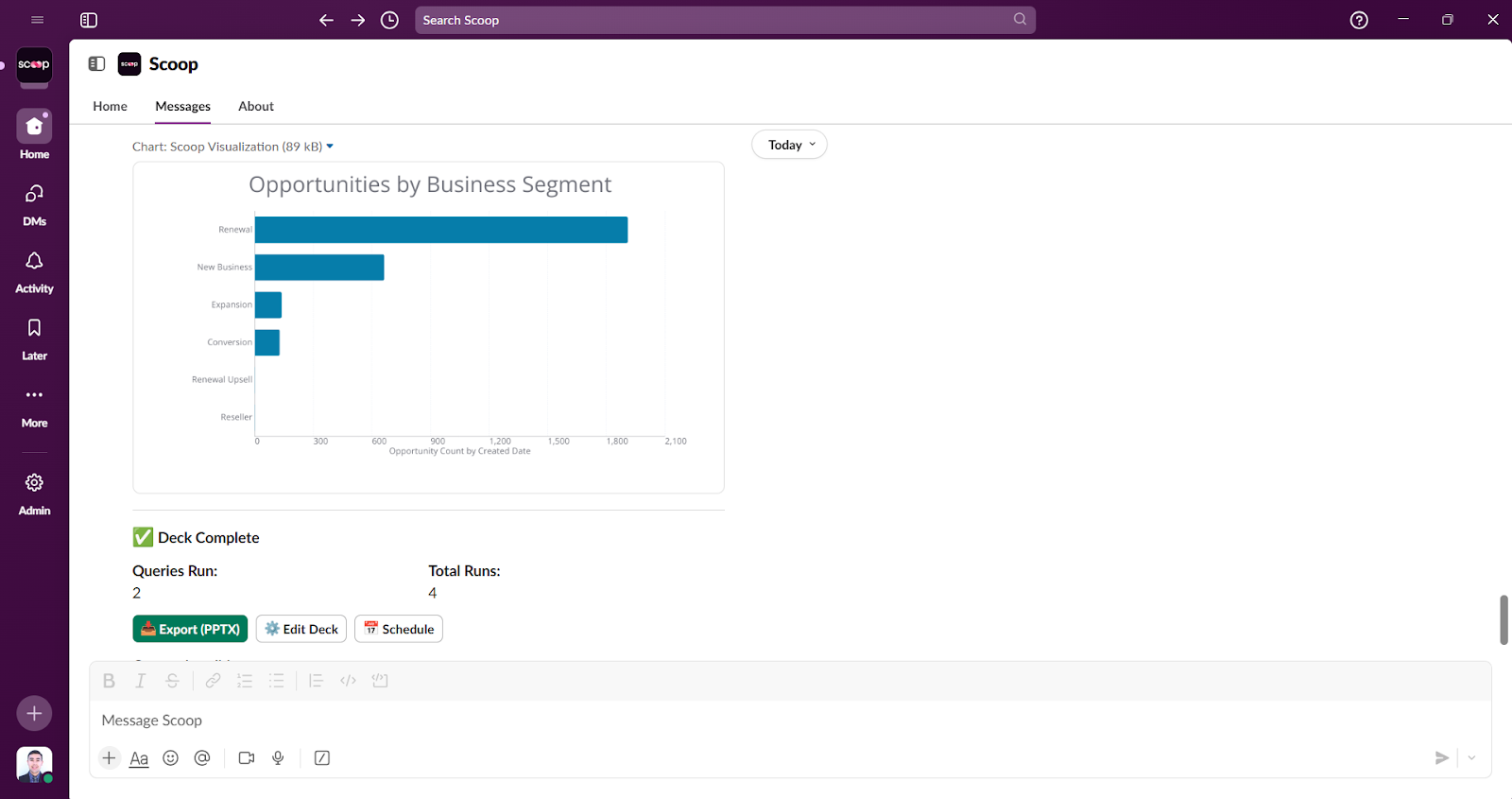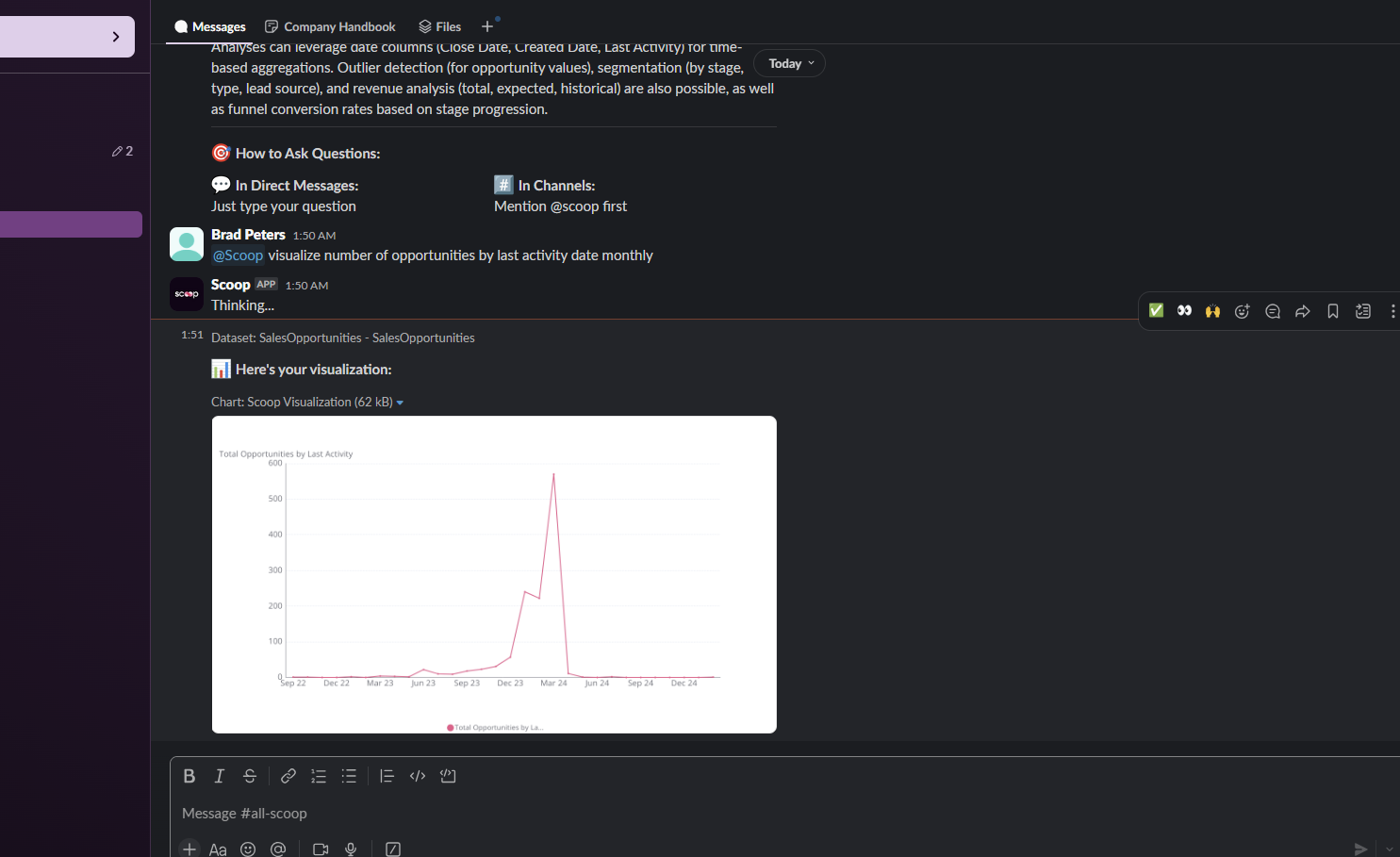AI analytics is shifting that dynamic. Marketing and revenue teams can seamlessly transition from audience insight to actionable campaigns, all within their collaborative environment. You can plan, explore, and launch campaigns in the very same conversations where questions are posed. This functionality processes behavioral data, surfaces key segment trends, and converts informal questions into structured, usable insights. Whether you're identifying warm leads or pinpointing effective messaging, the journey from initial curiosity to a launched campaign is streamlined and clear—all directly in your Slack.
The Marketing Bottleneck: Waiting on Insights
You have a big product launch coming up. Leadership wants a targeted LinkedIn push for the segment that converted best last quarter. But here’s what often happens:
- You request updated data from RevOps.
- They send a large spreadsheet.
- You sift through filters and pivot tables.
{{Call Out Component}}
In a fast-moving landscape, waiting for last month’s metrics just doesn’t cut it.
Ask. Answer. Act. In Slack.
Imagine a marketer types a question directly into Slack, like:
"Which campaigns drove the most pipeline from our HRTech audience last quarter?"
And instantly receives responses such as:
- Campaign A: $1.3M influenced pipeline, 2.7x conversion rate
- Campaign B: $875K pipeline, strong Q3 performer for HRTech
- Campaign C: High impressions, low downstream engagement
That’s not just a response—it’s prioritization. Structured answers surfaced instantly, in plain language. No tabs, no toggling.

The insights are dynamic. You can refine with follow-ups: deals over $50K, results by persona, trends over time. AI data analysts adjust in real time, helping your team move from question to action with minimal friction.
Target the Right Audience—Faster
Once you identify high-performing segments, it’s easy to go deeper:
- “What content themes resonated with FinTech in Q2?”
- “Which channels had the best cost-efficiency for enterprise leads?”
- “Who’s showing engagement but hasn’t booked a meeting yet?”
Scoop draws from CRM, marketing automation, and behavioral data to surface answers in Slack.
It’s particularly useful during strategic shifts—like updating your ICP or rolling out new pricing. Insights are grounded in live data, not static reports.
Beyond Basic Segments
By combining click data, session length, and CRM signals, Scoop helps marketers:
- Spot intent signals across campaigns
- Discover preferred formats by persona
- Stay updated as behaviors shift weekly
This gives teams a more flexible foundation for testing and iteration.
From Segment Insight to Campaign Action
Moving beyond just analysis, the goal is to drive direct action. You could inquire:
"Which retail accounts clicked 3 or more ads in the last two weeks but haven't scheduled a call?"
And in response, get:
- A downloadable list ready for use.
- A concise engagement summary.
- Recommendations for next steps, such as collaborating with sales or initiating a nurture campaign.
This effectively closes the gap between marketing insights and sales execution within a unified workspace.
Playbooks, Not Just Reports
Campaign learnings don't have to disappear into static dashboards. This approach lets you:
- Save segment definitions that perform well
- Track regional or vertical-specific campaign results
- Monitor benchmarks vs. past campaigns
With a growing internal library of segment behaviors and outcomes, your future campaigns can start stronger, built on a foundation of proven success.
No Dashboards Required
This capability isn't a replacement for your existing dashboards—it's an alternative when you need to move faster. Within Slack, the steps are straightforward:
- Ask a question
- Get an insight
- Launch the campaign

It's quick, flexible, and designed for business users, not just analysts.
Teamwide Visibility, Without a Sync
Instead of waiting for a meeting:
“Finance leads have 3x higher conversion from paid social. Worth reallocating some budget.”
Drop that in Slack, with a supporting chart. Everyone’s on the same page—without needing a calendar invite.
- Faster alignment with RevOps
- Easier feedback loops from Sales
- Clearer reasoning for creative pivots
Trends You Didn’t Know to Look For
Agentic analytics also surfaces what might have been missed:
- A campaign with strong engagement but weak conversion—and the reason why
- A new buyer segment behaving differently than others
- Mid-funnel content pulling in top-of-funnel leads
These discoveries often lead to better testing, smarter creative, and more relevant targeting.
One Example: From Friction to Lift
Imagine a marketing team noticing that Northeast-based mid-market tech accounts were engaging with ads, but not converting. They asked:
"What do these accounts have in common?"
The analysis revealed:
- Lower engagement on product pages.
- Higher interest in resource content.
- Stronger interaction with email compared to ads.
Armed with this information, the team reoriented their messaging around education, shifted their spending toward email nurture campaigns, and saw a 32% lift in bookings within just three weeks.
Let Curiosity Lead Campaign Strategy
Real-time AI data gives marketers more than convenience—it gives them control. When campaign planning happens through natural language queries and AI-powered analysis, curiosity turns into action.
- Faster experimentation
- Quicker optimization
- Better targeting, grounded in live performance signals
This is how marketing becomes proactive, not reactive.
New Use Case: A/B Testing Smarter with AI
One growth team wanted to compare two top-of-funnel webinar strategies—one focused on product education and the other on industry trends. They asked:
“Which campaign had better engagement-to-meeting conversion rates among our enterprise segment?”
Scoop surfaced:
- Higher initial clicks for industry trend content
- Better meeting conversions from product-focused content
- Most signups came via email on Wednesdays and Thursdays
The team doubled down on product-focused CTAs for enterprise, shifted campaign timing, and adjusted messaging across channels. The result? 25% more meetings booked over the next two cycles.

Campaign Review Templates & Reporting Efficiency
Marketing leaders frequently need to review past campaign performance with executives or external stakeholders. This process can be significantly simplified by enabling:
- Custom campaign review templates that can be triggered directly in Slack.
- Saved visualizations of cost-per-click and pipeline conversion by channel.
- Instant export to PowerPoint with aligned design and headings.
This capability not only saves hours of preparation time but also ensures everyone is working from the same, consistent data—eliminating the need for last-minute slide reworks.
Collaboration That Scales
Campaign collaboration shouldn't be slowed down by data access. This helps to:
- Reduce constant requests for data pulls.
- Keep campaign teams aligned with shared, live views of performance.
- Scale insights to other teams, like product or customer success, when they spot an uptick in user behavior.
This agility leads to better-informed launches, faster postmortems, and more momentum across your entire funnel.
Marketing Without the Wait
When insights and execution live in the same space, marketing gains speed, clarity, and confidence. With AI analytics integrated into your workflow, teams can stop waiting for answers and start acting on them.
This isn't about replacing your strategy; it's about giving your team more space to use it effectively. With instant access to performance patterns, audience behavior, and campaign suggestions, marketers can make sharper decisions in less time, without sacrificing depth or collaboration.
Whether you're responding to trends, optimizing an ongoing campaign, or building the next big push, you don't need to start from scratch. Just start the conversation.








.png)